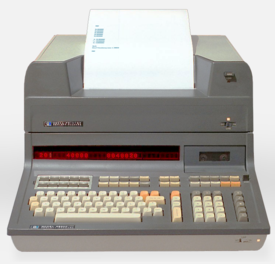HP 9800 series

HP Model 9830A calculator with optional Model 9866 thermal printer
|
|
| Type | Desktop computer |
|---|---|
| Release date | HP 9810A 1971, HP 9830A 1972 |
| Discontinued | Late 1970s |
| Operating system | ROM BASIC, expandable with ROM cartridges |
| CPU | Processor based on HP 2100 with stack |
| Memory | 16 kB ~ 64 kB |
The HP 9800 was a family of what were initially called programmable calculators and later desktop computers made by Hewlett-Packard, replacing their first HP 9100 calculator. The 9830 and its successors were true computers in the modern sense of the term, complete with a powerful BASIC language interpreter.
Chronologically, the models of the family were:
All 98x0 and 9821 systems used the same I/O interfaces. A 400 line per minute 80-column thermal line printer was designed to fit on top of the 9820 and 9830.
The success of the HP9830 led to a next generation with faster logic:
All the 98x5, with the exception of the 9805, used DC200 cartridge tapes, instead of cassette tapes. The 9825, 9831, 9835, and 9845 all used the same I/O interfaces. the 9815 had a unique I/O interface.
The HP 9800 series were developed by HP's Loveland division (Calculator Products Division), and later Fort Collins division (Desktop Computer Division). Early desktop computers were marketed as "Calculators" to make purchasing easier. At the time, some companies had different procedures for purchasing "Computers".
They spawned development of HP series 80, namely HP 85 and HP 87, that were smaller BASIC language computers with CRT displays. They came from HP's Advanced Products Division based in Corvallis.
For a short time in the late 1970s and early 1980s there was a class of similar desktop computers, such as the Tektronix 4051, IBM 5100 and Wang 2200 - before they were replaced in the marketplace by personal computers such as the Apple and IBM PC.
By the 21st century, Hewlett Packard would become the largest producer of personal computers.
HP 9830s were commonly employed at aerospace companies such as Boeing. They were also used by some schools such as Renton, Washington, which used pencil mark-sense cards with card readers to accommodate classroom use. An HP 9830 system with an integrated hard drive was also provided by HP in the early 1970s to National Real Estate Exchange, Inc., a small company in Florida, for its use in developing early real estate software. The U.S. Coast Guard devised a teletype message-forwarding system based on 9825As which were deployed as a working prototype for a subsequent purpose-built system, and also used them in the coordination of LORAN radionavigation transmitter chains. HP9825s were used in conjunction with Oscor software to score one-design yachting regattas in remote locations, such as the 1976 World Fireball championships in Nova Scotia, the World Windsurfing championships in 1976/1977 in Cancún and Bahamas, and also Laser championships. The HP9825 was selected because it was portable – the only alternatives were phone access to time sharing computers which was not reliable from these locations.
...
Wikipedia
